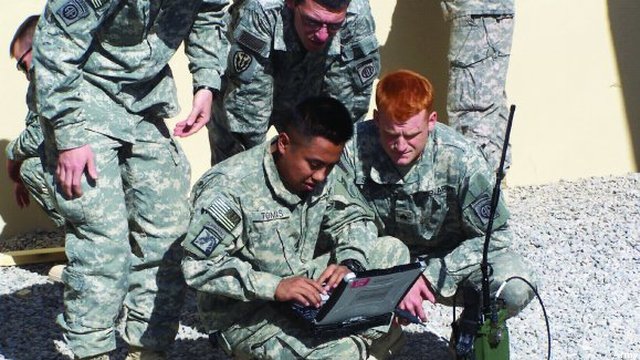No More Copper Wires: Army CIO To Tell Odierno We Gotta Go to Cloud
Posted on
 WASHINGTON: While Army forces in Afghanistan have more bandwidth and gadgetry than ever, bases back home still make do with archaic copper-wire telephone switches. As the war winds down and units increasingly operate out of the US, the challenge for the Army’s CIO is to move the whole service to a single set of compatible, cloud-based systems.
WASHINGTON: While Army forces in Afghanistan have more bandwidth and gadgetry than ever, bases back home still make do with archaic copper-wire telephone switches. As the war winds down and units increasingly operate out of the US, the challenge for the Army’s CIO is to move the whole service to a single set of compatible, cloud-based systems.
“How do we get the network right?” Lt. Gen. Susan Lawrence, the Army’s Chief Information Officer, aka the G-6, asked at an Association of the US Army breakfast. “We’re going to propose that [cloud-based] strategy to [Chief of Staff] Gen. [Ray] Odierno on Saturday the 17th.”
Already, Lawrence said, she is “working with our teammates in Congress” and with Army chief acquisition executive Heidi Shyu to reform the service’s buying process for information technology. “Ths is my number one priority this year,” Lawrence said. “Do the Federal Acquisition Rules need to be changed? Does [Defense Directive] 5000 need to be changed?”
Lt. Gen. Lawrence says the Special Forces model of small, rapid acquisitions is the one to follow — as much as the much larger “Big Army” can sale up SOF’s approach for its community of three million uniformed and civilian users. Traditional IT acquisitions take an average of six years, which is unacceptable, she said. Currently, some programs are coming to fruitiion within “18 to 36 months,” she said. “That’s still not good enough.”
“Big programs for IT is NOT the way ahead….No more Task Force JTRS,” she added, provoking laughter at her linkage of the much-troubled and mostly-cancelled Joint Tactical Radio System to the notoriously unready Task Force Smith that was overrun by North Koreans in 1950.
While JTRS floundered, the Army decided to buy off-the-shelf radios for its forces in Afghanistan and Iraq. It also pushed out successive upgrades of command-and-control networks at multiple echelons, from Blue Force Tracker for small units to the Warfighter Information Network – Tactical for higher headquarters.
That rush to upgrade frontline units has resulted in a patchwork of systems that always don’t work well together. At a recent Network Integration Evaluation, the Army’s twice-annual testing at White Sands Missile Range, New Mexico, the service counted “13 different handheld operating devices [and] about 76 different NetOps [network operations] tools” in use, Lawrence said, and you could find a commander “sitting in his Humvee with five screens around him,” each providing data from a different, stovepiped system incompatible with the other four.
“We cannot afford to do that any more,” Lawrene said. “The standards have to be open and secure so that we can turn on a dime.”
At least those forward units already have fairly modern technology. Back home, many Army bases still rely on archaic telephone switches using copper wires. “Those old analog switches keep me awake at night,” she said. “Another went down at Fort Bliss while we were doing our testing.” In wartime, it is right and proper to focus investments “on point” in combat units, Lawrence said, but as forces overseas draw down and the Army increasingly operates out of its home bases, it’s time to bring those bases into the current century.
Replacing busted switchboards would have taken $200 million on the retail market, she said, and $140 million through GSA, the government’s General Services Administration, but after hard bargaining and some industry innovation, “we bought the entire buy for $23 million,” she bragged. “In FY 13 we are going to move quickly and get these old broken switches out of there.” (That’s assuming, of course, that the automatic cuts known as sequestration do not take effect in January and scramble all federal spending for the rest of 2013).
Replacing those old switchboards is part of a military-wide IT upgrade. In 2011, the Army began migrating hundreds of thousands of email addresses from various scattered, unconnected networks to centralized “cloud” servers managed by the Defense Information Agency. That process is far from complete, Lawrence said — “we continue to find rogue networks out there; we just found another one last week” — but the objective is to consolidate to 22 Defense Department servers worldwide, five of them serving the Army.
Under the cloud approach, which stores users’ files on centralized servers instead of their individual laptops, desktops, and mobiles, “we’re taking the data off your devices,” she said, “[so] when you go home at night and you lose your laptop in the taxicab… that’s ok” – at least in the sense that you haven’t lost control of any classified or sensitive information.
Of course, the problem with cloud computing is that while your data may be safe on the central servers, you can’t reach it if the network goes down. That makes security and redundancy particularly critical. “We will never send a unit out with a single means of communications,” Lawrene said. And if the central servers themselves come under attack, they are backing up their data to one another several times a day, so users can quickly switch from one to the other — although, she acknowledged, “they will lose some data.”
Migrating most functions to the centralized servers of the cloud and reducing personal devices to relatively “dumb” terminals can improve security, if it’s done right. But as the military refocuses from fighting Taliban “cavemen” to more sophisticated foes, it needs to think hard about securing the digital networks on which it has come to depend.
Subscribe to our newsletter
Promotions, new products and sales. Directly to your inbox.
